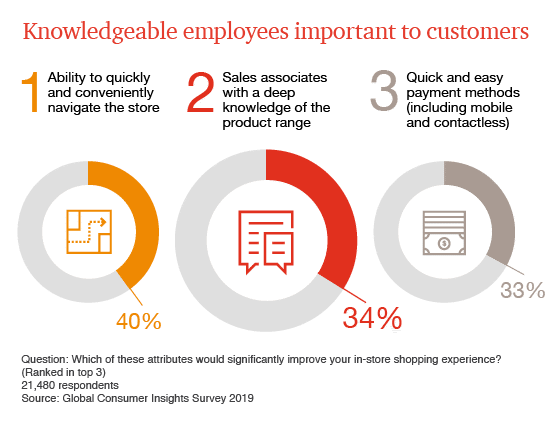Perhaps no other industry has been impacted by changing customer demand like retail. People want to have 24/7 shopping experiences, and they want it now. However this trend did not crystallize into one channel taking dominance over the others, rather the expectation is to be consistent across all channels in the value chain. Which is why a lot of the Retail Apocalypse proponents, have found out that also traditional brick and mortar retail still has a meaning.
I have already addressed how I believe the work in retail is changing. And have also more recently argued that the expectations put on Retail Associates need to be compensated adequately. What I want to focus today, however, is the extent to which Digital Transformation should become an important topic to be addressed at the Store Level.
We have already seen that traditional organizations need to think of Digital in terms of a process of cultural maturity, and not in terms of a single transformative event. This means that retailers cannot forget their store employees in their journey, as these are a big part of their population. We all know the concept of Tipping point, and the necessity to involve a high number of people to make change happen, especially in large and diffused organizations.
One of the obstacles that we have with retail, is the tendency of considering store associates just the “periphery of the empire”, pure executors of directives. When change needs to happen, normally a one-size-fits-all approach is applied, trying to seek economies of scale vs. effectiveness, which in the reality doesn’t work.
A typical issue I see in Retail is that we assume that, because on average we might have younger people working in store, they are “naturally” digital. There are more factors at play, including fact that some people looking for low paid jobs in retail, come from economic backgrounds that might have limited the access to technology. Plus, there is also an attractiveness issue: if it is sure that some retailers (think Apple) are able to attract true digital natives, what about retail segments that are perceived as less technological? In a recent experience we noticed that a sample of retail employees had a very low technological penetration compared to expectations: more than. 30% did not have an email address, and 20% did not have a smartphone.
Solution is not just adding any technology in store: employees need to understand their role within the entire Consumer Journey in terms of Shipping Experience. Also because, time after time, it is confirmed that knowledge of workers is one of the key factors in the shopping experience, as the latest PWC Global Consumer Insights survey shows.

And BTW, also item 1 (ability to navigate the store) can be heavily impacted by the way store associates interact with customers.
Too much of the Omnichannel craze has been pointing solely or mainly on the implementation of new technologies in store. Yet hoe many iPads shipped in store, ended up into a drawer because we never took the time to ask and involve associates in how this tool could be used across the journey in store.

Building a Digital DNA
One of the main issues is how can we give our sales associates the minimum of skills needed to thrive in this new digitized world. Which is not about just training on new technologies, but ensuring awareness is created across three key building blocks of skills:
- Human Skills apply social, creative and critical intelligence. These skills – critical thinking, creativity, communication, analytical skills, collaboration, and relationship building – appear on many lists of sought-after “soft skills,” and are needed in the way we deliver memorable experience to customers.
- Digital Building Block Skills are critical for many specific jobs, and increasingly useful also outside traditional digitally intense job families. In the field of retail, these skills include analyzing data, managing data, digital security and privacy as well as general understanding of social media and digital communication.
- Business Enabler Skills play a synthesizing, integrative role
in the workplace. These skills allow the other skills to be put to work in practical situations, and include basic communication, all business process knowledge, business acumen and new ways of working.
What new technologies offer is the possibility to enable associates to develop variegated profiles, leveraging preferences across the above building blocks. Good store management should be empowered to ensure team diversity covers by creating the right mix.
Avoid too much focus on productivity
One of the issue we seem to face is that in recent years there is a lot of focus on productivity. Per se this is not incorrect, however too often we are “stressing” retail associates because traffic in store has been decreasing, and the profitability of the brick and. mortar store is suffering. Again, a channel-focused financial model might be the cause, as many sales originate in store, but happen in other channels (digital and non).
What this means is we have less people (of less quality, as we often have to resort in giving less hours and more base pay contracts), which in turn are unable to deliver the shopping experience that is needed.
It’s the retail associates who make the experiences come to life, who solve problems, who connect one on one with their neighbors in the community, who know their products and brands inside-out and backward. They’re less cashier-behind-the-counter and more community ambassadors living and breathing the brand.
Carol Leman, Brick-And-Mortar Retail Is Changing — Associates Need To Change, Too
If the above is true, how can we really make these associates to champion the experience for our brands? What I suggest is to make them the real core of your Digital transformation effort. Do you agree?

Cover Photo by Roman Kraft on Unsplash

Hi Sergio,
very true, thank you for this post.
Often enough store staff is just overwhelmed by technology after technology thrown at them and get very frustrated by the expectations to magically increase productivity this way. This is not how things work I believe. Technology can really do a great job help building brands and create excellent shopping experience, but in the end it is mainly about humans.
So:
-store staff needs much better feed back about the important role they play in this journey. No matter where sales are generated in the end.
-adequate compensation is a big issue in Retail
-stores are understaffed too often for too long, just because it became so hard finding the right people, working conditions are often not attractive, sickness rate is high, motivation and drive suffers.
-too often store managers end up with underqualified and bored staff, simply because there is no one else who wants the job.
Having worked in Retail Field Management for +20 years I know that many store staff also feel a huge amount of arrogance and lack of understanding of how challenging working in a store really is, and this is due to the attitude and behaviour of their headquarter colleagues and managers.
I
I would bet that 80 % of those people who work behind their office desks Monday to Friday from 9 to 5 (of course sometimes more) and think they know it all would not even survive one Christmas peak in a busy store.
Best regards
Heike
Very true. There’s definitely the need to ensure store employees don’t see technology as the enemy anymore, but this cannot just be told “top down”. There’s a need for shared willingness to introduce working technology that enables better consumer journeys.
[…] The most important step in the definition of an Employee Journey, is in my opinion the identification of the Moments of Truths. Identified first in Marketing, these have been immediately tied in with successful delivery of Customer Service. These are defined as “those few interactions (for instance, a lost credit card, a canceled flight, a damaged piece of clothing, or investment advice) when customers invest a high amount of emotional energy in the outcome”, and are strongly linked to the capability of employees to handle these moments beyond expectations. An important reminder of the need to focus on frontline employees. […]
[…] store associates (i.e. pay more to get more), retailers will not succeed especially in the wake of Digital Transformation affecting the […]